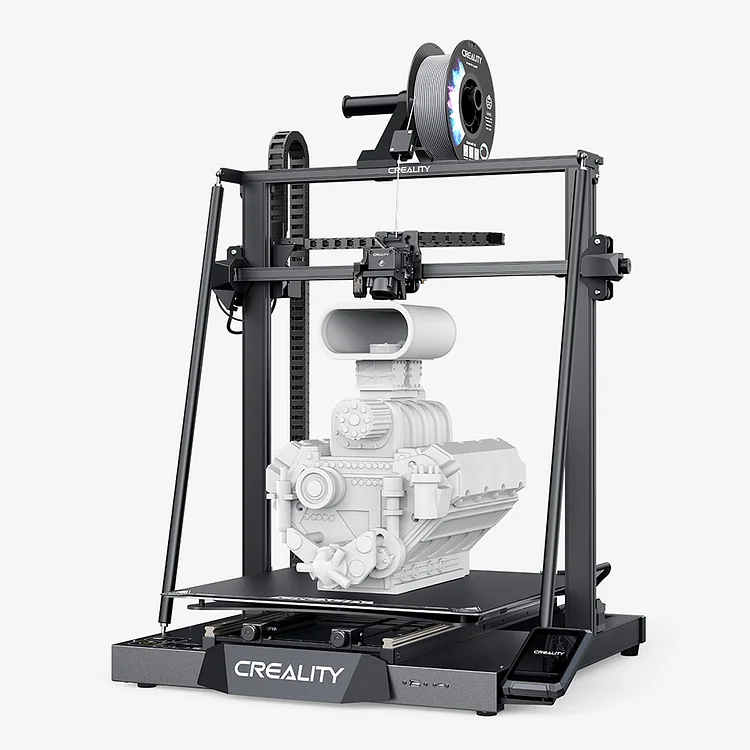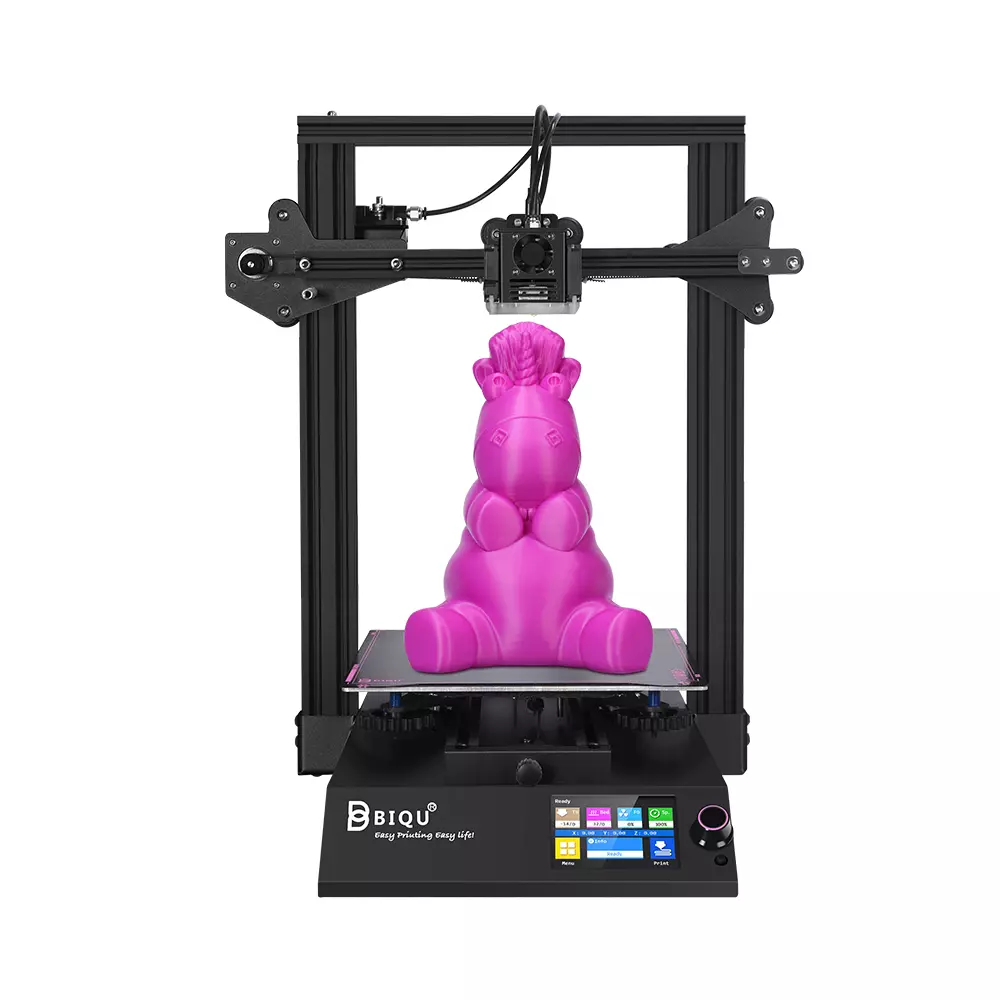Compare CR M4 vs BIQU B1
Comparison between the best 3D printers
Choose the best 3D printer at the best price. The cheapest 3D printers are here.
Buy a 3D printer here with 3D Fila.
 |
 |
|
| Model | CR M4 |
BIQU B1 |
| Printing Material | Filament | Filament |
| Buy Filament for Creality 3D CR M4 | Buy Filament forBigTreeTech BIQU B1 | |
| Estimated price | $1099,00 | $269,00 |
| Manufacturer | Creality 3D | BigTreeTech |
| Release Year | 2023 | 2020 |
| Print Volume [mm] | 450x450x470 | 235x235x270 |
| Printer Size [mm] | 655x700x865 | 412x402x492 |
| Weight [kg] | 23 | 8,00 |
| Power Loss Recovery | YES | YES |
| Enclosed printer | NO | NO |
| Bed Leveling | Automatic | Manual |
| Filament End Sensor | YES | YES |
| Bed type | Heated | Heated |
| Power supply system | Direct Drive | Bowden |
| Standard nozzle | 0,4 | 0,4 |
| Maximum Nozzle Temperature [°C] | 300 | 250 |
| Maximum Bed Temperature [°C] | 100 | 100 |
| Maximum printing speed [mm/s] | 180 | 100 |
| Filament holder | YES | YES |
| Camera for supervision | NO | NO |
| Recommended filaments | PLA, PETG, TPU, ABS, PLA-Wood, PA, PLA-CF | PLA, TPU, ABS, PETG |
| Recommended slicers | Cura, Simplify, Slic3r, IdeaMaker | Cura, Simplify, Slic3r |
| Maximum Resolution [mm] | 0,1 | 0,1 |
| Processor | 32 Bits BTT SKR V 1.4 | |
| Display | Display touchscreen 4,3'' | Touchscreen TFT 3,5'' |
| Power Supply | 110/220V / 800W | 24V / 360W |
| Connectivity | SD / USB / Wi-Fi | SD / USB |
| Operating systems | Windows, Mac, Linux | Windows, Mac, Linux |
| Date of registration in the system | 2023-02-06 | 2021-04-14 |
| Release date | 2023 | 2020 |
| Extra features | The Creality CR-M4 printer stands out for its easy assembly and automatic table leveling. With dual-gear extruder technology and direct drive, it ensures quality prints. It offers Wi-Fi and LAN connections for easy file sending. Its large construction volume of 450x450x470 mm allows for bold projects. It has linear rails and a high-power Y motor, supporting up to 30 kg on its plate. The innovative design includes an efficient cooling system and a removable screen controller, optimizing usability and comfort during printing. | The BIQU B1 is an advanced 3D printer with a silent 32-bit BTT SKR V1.4 motherboard and ARM Cortex-M3 CPU, offering DIY interfaces (I2C, SPI, WiFi) and dual Z-axis. Its dual BTT B1 TFT35 V3.0 operating system allows real-time monitoring and multiple printing modes, including G-code visualization effects. It stands out for its BIQU SSS (Super Spring Steel), ensuring easy model adhesion and simplified removal, with the possibility of using it on both sides. It includes a filament sensor, automatically pausing printing in case of filament breakage. The multicolored RGB lights integrated into the hotend allow you to view the printing status even at night. Additional notes include the need for a BIQU-specific Type-C cable and extra interfaces for smart filament sensor and BL Touch. |
| Support for multiple colors and materials (AMS and CFS) | NO | NO |
Notes * |
||
| Cost-benefit | 6 / 10 | 7 / 10 |
| Hardware | 2.8 / 10 | 2 / 10 |
| Tela | . | . |
| Print volume | 4 / 10 | 3 / 10 |
| Performance | 1 / 10 | 1 / 10 |
Conclusion |
| In comparing the CR M4 and BIQU B1 3D printers, both models offer distinct features that cater to different user preferences and requirements. The CR M4, being a more recent model, boasts a significantly larger print volume, allowing for the creation of larger and more ambitious projects. Its automatic bed leveling simplifies the printing process, making it more accessible for novice users, while the direct drive power supply system is advantageous for a wide range of filament types. Additionally, the CR M4's higher maximum nozzle temperature and printing speed make it a formidable option for users seeking efficiency and versatility in printing. On the other hand, the BIQU B1 stands out for its compact size and lower price point. It features reliable manual bed leveling and an efficient dual Z-axis system, which can be attractive to users who enjoy tinkering and customizing their setups. Its silent 32-bit motherboard ensures smooth operation, and the unique Super Spring Steel bed enhances print adhesion and eases model removal. While its performance specifications are more limited compared to the CR M4, the B1 provides a cost-effective solution for beginners or those focused on smaller projects. Ultimately, the choice between the CR M4 and BIQU B1 will depend on the users' specific needs. The CR M4 is well-suited for those who prioritize larger print volumes and advanced features, making it a worthy investment for serious enthusiasts or professionals. The BIQU B1, however, presents a budget-friendly option with solid performance for smaller-scale printing tasks, making it ideal for casual hobbyists or users new to 3D printing. In summary, both printers have their advantages, and choosing the ideal model hinges on project size, desired complexity, and budget considerations. |

